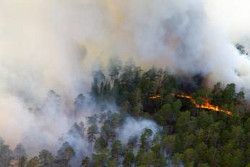Wildfire and Air Quality#
Should you consider limiting your time and activities outdoors due to poor air quality? View the Air Quality and Outdoor Event document for guidance.
Wildfire and Health#
Smoke is made up of a complex mixture of gases and particles including fine particulate matter (PM 2.5). These microscopic particles can get into your eyes and respiratory system which can irritate the lungs and lead to a range of symptoms. Symptoms of smoke exposure include:
- Watering and irritated eyes
- Coughing
- Wheezing
- Difficulty breathing
While smoke can impact anyone, sensitive populations such as children, pregnant people, the elderly, and those with asthma and other respiratory concerns are especially at risk during a smoke event.
How to Prepare for Smoke Impacts from Wildfires#
Because smoke travels, smoke from long-range fires can impact air quality and health even when you cannot smell or see smoke. The best way to know your potential risks due to smoke from wildfires is to be aware of what the air quality is in your area. Check the Air Quality Index and pay attention to Air Quality Alerts in your area.
The Colorado Department of Public Health and Environment provides Wildfire Smoke Health Advisories and Smoke Outlooks along with more information and resources concerning health risks from wildfires.
Sign up for Air Quality Alerts
What You Can Do to Minimize Impacts from Smoke#
-
In your home
- Close windows and doors
- If you have an air conditioning (AC) unit, set it to recirculate
- Minimize exposure to other indoor air pollutants:
- Don’t vacuum during a smoke event
- Limit stove-top cooking
- Once the smoke has dissipated, open windows to ventilate home
- If you do not have AC, designate one room in your home to be a clean air room. Learn how to create a Clean Air room.
- Learn about Portable Air Cleaners
- Learn more about Indoor Air Quality and Wildfires
-
In your car
- Close windows
- Run AC in recirculation mode
- Change air filters every 20,000-30,000 miles
- Do your best not to drive in smoky conditions
Frequently Asked Questions#
-
A mask or respirator may help to reduce exposure during a smoke event. It is important to learn how to protect your lungs from wildfire smoke or ash.
Other considerations:
- Do not rely on dust masks or bandanas during a smoke event. These are not effective in reducing fine particles that you are breathing in
- If you feel the need to use a mask during a smoke event, consider N95 or P100 Respirators
- Even with a mask during a smoke event, it is a good idea to limit activities outside
-
While it is an individuals’ choice on when to limit activities, once air quality values approach moderately high, you may be affected and should consider limiting your activities. Learn more about the Air Quality Index levels of health concern and read through the Outdoor Event Guidance Document for the City of Fort Collins.
-
Sign up for NOCO Alerts to be aware of evacuation alerts in your area.
Additional Resources#
For additional information, visit the following websites:
- Covid and Clean Air Shelter Guidelines from CDC
- Wildfire Smoke and Covid-19 from CDC
- Outdoor Event Guidance Document
- Front Range air quality forecast from Colorado Department of Public Health and Environment
- Nationwide air quality conditions and forecasts from AirNow.gov
- Active fire maps from USDA Forest Service
- InciWeb, up-to-date information about specific wildland fires
- Learn more about how to protect yourself from smoke impacts
- Wildfire Smoke Preparedness Rack Card from City of Fort Collins
- EPA Wildfire Smoke Guide for Public Health Officials
